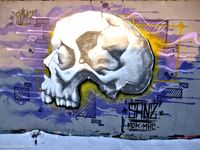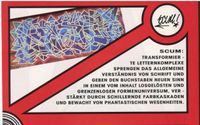SANZ
IG @sanzone.adk.mhc
Sanz is well known for his immense variety in characters and wild-style pieces. He is part of the mid-generation of Munich's graffiti scene and is a member of the ADK artist collective, Der Blaue Vogel. Sanz collaborates regularly with his crew on local art festivals in Munich and on worldwide projects, painting murals abroad. These include Austria, Croatia, Poland, the Czech Republic, Spain, Italy, Slovenia, the Netherlands, France, the USA, Canada, Brazil, Turkey, China and Indonesia. The murals often include the famous blue bird.
SATONE
SatOne born in 1977 in Venezuela and since 1979 in Munich was inspired by his early travels. One of the trips he has undertaken in the early 1990s brought Graffiti to his attention. From 2000 on, he developed a distinct abstract style, which starts with figuration and objects, but the color fields that develop from it overcome any references to the living world. Abstract in nature, SatOnes art is an expression of sensitivity present in objects that can be realized only on an instinctive level.
In 2017 SatOne collaborated with Axel Void at the Scale Wall Art (on the Siemens grounds) project, calling their artwork Harmony. SatOne explains the background to the mural:
"This mural is based on an image taken in 1945 of the atom bomb in Hiroshima, Japan."
HEIKO SCHIEMANN, PETER WATZL
Heiko Schiemann was a pivotal figure in Munich's graffiti scene in the 1980s, documenting the city's walls with his camera from an early stage. In 1986, Schiemann published his photographs alongside Peter Watzl's text in the book Munich Graffiti. This publication is a landmark in the history of Munich's graffiti culture and is now traded at high prices on the book market.
SCKRE
video-sckre.com, IG @sckre27
Sckre, renowned for his distinctive style characterised by ornamental, abstract landscapes, shapes, and forms, specializes in captivating scenic art. His work focuses on large-scale murals, graffiti and commissioned art projects, often exploring themes of nature and creation. As part of the artist duo VIDEO.SCKRE, VIDEO focuses on the characters of animals in motion and transition, while SCKRE connects them with his ornamental, abstract landscapes, shapes and forms.
SCOUT
SCUM
Well established writer from the first generation. Active across Munich, participating regularly at spray jams and exhibitions.
SHAMEY
blackrabbit.ink, IG @_shamey_
Shamey began his career in the late 1980s as part of Munich's legendary ABC and TSR crews. Heavily influenced by comic and tattoo art, Shamey’s distinctive style is characterised by its vibrant use of colour, spray paint, brushes and airbrush techniques.
SHOE
nielsshoemeulman.com, IG @nielsshoemeulman
In the mid-1980s, the Hall of Fame at the Dachauer flea market became a magnet for international artists. Among them were Loomit's friends Shoe, Cat22 (NL) and Bando (FR) from the Crime Time Kings who traveled to Munich in December 1986. On the final night of their visit, they were caught and held at Stadelheim prison for two weeks. Loomit was lucky that night, as he had to work that evening.
Fast forward to 2023, and this time, Shoe was officially invited to Munich to paint. In the Munich Art Tunnel he created a piece reflecting his experience in Munich in 1987 when he was caught and sent to prison. The mural served as a symbolic homecoming, showcasing Shoe's evolved style, characterized by fluid, expressive letterforms, and his journey from a rebellious young writer to a respected figure in the international art scene.
SIOUX
Esteemed writer, well known in the graffiti scene, to the police and the press as well. In 1988 Süddeutsche Zeitung mentions his work:
"‘Sioux’, one of the “kings” of the Munich sprayer group ‘club of rome’, immortalised himself over a length of almost 23 metres on an S-Bahn carriage on the S6 line at the Herrsching terminus at night at the beginning of April. In large, silver-coloured, black-edged, swinging ‘letters’ on a red-brown background, it reads something like ‘AZTEC HEMO’. It is a so-called ‘top to bottom - whole car-piece’, i.e. a lettering that takes up the entire height and length of a S-Bahn train, with ‘to Rayo - get well - Soom’ written in smaller letters next to the nine large letters. Perhaps a dedication or, as the jargon goes, a "dedication" to a friend?" (Wer sprüht muss zahlen, Annamaria Sigrist, 28/29.05.1988)
SITY
IG ©sity.one
Sity, also known as Crash, was part of the first generation to be active at the Dachauer Hall of Fame, and was a member of the famous ABC and The Subway Rockers crews. In 2020 he published "Fame - Sprühen, Kiffen, Prügeln. Unser Kampf um Anerkennung" (Spraying, getting high, fighting. Our fight for recognition), recounting his initial experiences with graffiti and train writing in the late 1980s, his encounters with drugs, and how religion has helped him to this day. Highly respected, Sity now works as a teacher on educational youth art projects and regularly participates in spray events.
SLANT
SMITH
Part of the first generation, sprayed only in 1983 and 1984, sometimes together with Cheech. Unfortunately little is known about Smith to this day.
SONIC
SONIC
IG @soniconer
SOKO GRAFFITI
As a consequence of the first whole train, the Geltendorfer Zug, the Munich railway police formed an investigative commission (Sonderkommission - SOKO) in 1985, which soon became Germany's first specialised graffiti task force. The late 1980s saw a game of cat and mouse, which was sometimes reported in the local press.
Photo caption: "On the trail of taggers: Illegal graffiti artists are causing major concerns for the Munich railway police. That’s why a unique “Graffiti Task Force” was established in Germany two and a half years ago. Our picture shows two of the officers at work." (Wer sprüht muss zahlen, Annamaria Sigrist, 28/29.05.1988)
"BOLDNESS that comes at a high price: thanks to the successful deployment of the special railroad police unit, spraying in Munich's underground has become extremely risky for the “writers” If they are caught, they can expect to be sentenced to several months in prison by a juvenile court judge in the event of a repeat offense. In addition, they also have to bear the not exactly small cleaning costs." (Wer sprüht muss zahlen, Annamaria Sigrist, 28/29.05.1988)
In 1989, Playboy magazine covered the Munich scene, featuring Neon, Cemnoz, Milk, Techno and Won. The article showcases both the artists' perspective and the police's perspective. Describing a typical night for the police officers Norbert Wittmann und Thomas Mante from the special graffiti unit:
"Four to five times a night, they huddle in the cold for what feels like half an eternity, waiting at a distance from a parked S-Bahn train for any sound, movement or irregularity that might betray the presence of the boys. The only suspects they usually find are a dozing train driver or a squirrel, neither of whom can easily be arrested." ("Babu go Home", Bertram Job, Playboy, Nr. 7, July 1989)
SONIDO CARIBE
SOREL
SPYS
A first-generation artist from Munich, he was one of the first to spray a series of highly acclaimed works in the winter of 1983/84, mainly in the west and western suburbs (e.g. Lochharn and Gräfelfing).
START
STATISTICS
Some numbers from Germany and Munich, by the police and German Railway (Deutsche Bahn -DB) - more stats will be added as available.
1981 - In Munich, 500 graffiti were removed at a cost of 50.000 Deutsch Marks (DM) to clean the city's buildings.
1988 - The cost per S-Bahn wagon for a new coat of paint is over 96,000 DM.
2007 - 11.341 illegal works registered in Munich by the police. 2.4 million Euro damage, with 80 % being on subways.
2024 - The Deutsche Bahn reports 12 million Euros in damages nationwide, primarily affecting S-Bahn trains, regional and freight trains, bridge pillars, platform accesses, and noise barriers. In the process, 3,200 perpetrators were caught in the act. From January to October 2024, Deutsche Bahn recorded 843 offenses in Munich, compared to Frankfurt am Main (233), Hamburg (225), Leipzig (202), and Dresden (179).
STEVE
IG @steve.glas
Steve is part of the first generation of style writers in Munich, having been active since 1985. Over the years, his inner urge to colourfully transform the environment has resulted in countless walls featuring his very own unique styles and characters.
Steve's pictures are characterised by clear lines and shapes, offering viewers exciting details to explore. In addition to participating regularly at spray jams and exhibitions, he also works as a successful graphic designer with an extensive portfolio.
STIX
From the mid 80's, not much is known about this artist or crew. This is one of the walls which the Munich construction department had copied and measured before cleaning the wall (see also Baureferat).
STOP BOMBING CIVILIANS
The "Stop Bombing Civilians" campaign by Handicap International (HI) featured a graffito by Lion Fleischmann, Lando and Scout to raise awareness about the devastating impact of explosive weapons on civilians. In October 2021, the artists created a large-scale mural at WERK9 in Munich's Werksviertel-Mitte depicting a family seeking protection from bombs. The mural emphasizes the campaign's message that 90% of victims of explosive weapons in populated areas are civilians.
STREETLOVE
streetlove-magazine.com, IG @streetlovemagazin
Based in Stuttgart, Streetlove – Stylewriting & Hip Hop Kultur Magazine has been publishing its high-quality magazine for over a decade. In 2021, the magazine released a special feature on the Munich scene. This included in-depth articles and photographs of the Tumblingerstrasse scene from 1992–1994, as well as an interview with the artist Cowboy69 about his work at the Hall of Fame and being part of the famous ABC and TSR crews. To celebrate the 30th anniversary of the renowned Munich hip-hop band Main Concept, the magazine also included an in-depth interview.
SWING
SYKER











.jpg/picture-200?_=1974b079a98)













































%20copy.jpg/picture-200?_=197460b57f0)








.jpg/picture-200?_=19724e8bee0)



-2.jpg/picture-200?_=193a57d9c88)






.jpg/picture-200?_=1974673cf25)




















